
- 3-minute read
- 23rd June 2021
How to Cite Personal Communications in IEEE Referencing
Did you know you can cite private letters and emails in your work? Here, we’ll explain how to cite personal communications in IEEE referencing.
When Should You Cite Personal Communications?
In IEEE referencing, a ‘private communication’ can be many things, including:
- Unpublished letters and emails
- Direct messages on social media
- Office memos or other private documents
- Face-to-face or phone conversations
Essentially, it covers any communications between individuals that aren’t publicly available. These are not, traditionally, considered scholarly sources. As such, you should always cite a more reliable source if one is available (e.g. a published book or journal article would be a better source in most cases).
However, private communications can be useful sometimes. For example, if you email an expert to clarify something they discuss in a published paper, you could cite your correspondence as a supplement to the published source.
If you do need to cite personal communications, moreover, IEEE style has a specific format to follow. Read on below to find out how this works.
Citing a Personal Communication in IEEE Referencing
In-text citations in IEEE referencing use numbers in square brackets:
According to Steiner [3], the rover’s navigation system allows it to detect and circumvent hazardous terrain during its descent through the atmosphere.
These numbers point to sources in the reference list, numbered in the order you cite them (i.e. the first source is [1], the second source is [2], and so on).
Find this useful?
Subscribe to our newsletter and get writing tips from our editors straight to your inbox.
For more on how to format IEEE citations, see our blog post on the topic.
Personal Communications in an IEEE Reference List
In an IEEE reference list, the basic format for any private communication is:
[#] INITIAL(S). Surname, private communication, month, year.
For instance, the reference for an email from Elon Musk might look like this:
[2] E. Musk, private communication, Apr. 2020.
As shown above, you may need to abbreviate the month here. This applies to any month with five or more letters. To abbreviate a month, simply use the first three letters followed by a full stop (e.g. ‘August’ becomes ‘Aug.’). However, you won’t need to abbreviate ‘May’, ‘June’ or ‘July’ as these are all under five letters long.
Expert IEEE Proofreading
As you can see above, citing a personal communication in IEEE style is simple. However, if you’d like to make sure your references are error free, try our free proofreading trial today and find out how expert editing can help!




